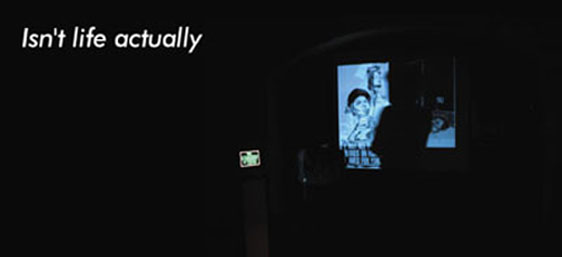 Image Engine
Image EngineA project based on the image archives of the web by Róza El-Hassan
» 1998 «
WORKS FROM THIS YEAR:
» IMAGE ENGINE« ------------....................----» ANASTASIA «
................................................................................
 Image Engine
Image Engine
Last winter, before starting to work on the Image Engine, I was dealing with an aspect of inconsistency in electronic media: a media which we call audio-visual, and which should relay sound and image. In spite of this, the only possibility to approach any information is via text-string designations. The sole access we have to the expanding universe of image-archives is offered by a system based on traditional library structure. Each still picture or animated film fragment needs to be labeled with a name and number in order that we ever be able to look it up or recall it again. Codes for the system in numerical form are most appropriate; however, rather than analysing this format, I concentrated instead on access via words, as we cannot establish a mental relationship to a system administrated merely by numbers. Access codes strictly in the form of numbers might be compared to a telephone book which offers numbers in both columns rather than names and numbers.
Hence the alternative possibility for placing images into archives is by labeling them with text-strings, and this is a truly delicate affair. It is not by chance that traditional collections refer rather to the author, date and place of origin than to short descriptions of what is visible in the picture. Considering the fact that the digital image has been stripped of all of these identifying factors, I started to examine the existing Image Search systems on the Internet, offered by the big commercial search engines. Many of them have so-called "image search" options (e.g., Lycos terminology, AltaVista Photofinder), but there is also independent search software (Image Wolf, Gif Runner), developed specifically for the purpose of to searching image files (e.g., jpeg, gif, animated formats, etc.) from the Internet. When we feed these programs with a single word, expression or chain of words (or sentence fragment), we receive a steady flow of downloaded images - in the course of just a few hours, thousands of images for just one word, all of them stripped from their context.
Initially, this gave me the idea to handle this tool as a kind of "idea-browser" (as in the idea of Plato); after obtaining hundreds of pictures of "Chair" or "Table", any measure of expectation of aiming a way to condense the result seemed terribly naēve. Thus, instead of summarizing the result, I proceeded with browsing images for more abstract concepts like "The Scream" (which was later the basis of the sculptural work I did in Sao Paulo). Furthermore, I was interested in the visual appearance of Evil, which appears on the Net primarily as a comic figure. But no matter what sombre or abstract word I chose, all of these picture-catalogues were merely reflecting the nonlinear structure of a database. Each element of the enormous quantity of visually heterogeneous materials was anchored to text, but the coherent energy which could have replaced a linear linguistic structure was still missing.
Socrates had a long discussion with Cratylos about the nature of the instrument which brings order to the fabric of names and substantives. Here I could quote the entire Cratylos dialogue in its depth, with reference to the relation between language and objects, as well as pictures, but this would be much too extensive. Nevertheless, it is entirely appropriate and timely with regard to this situation in which we aim to order the whole web by giving names to the most arbitrary phenomena, image and sound fragments. So much for the theoretical questions which took my attention, as well as the attention of many others recently.
Subsequently, these researches offered me the possibility to unravel a text via the steadily changing and floating image material while reordering the pictures along the line of a narrative. At this time, I became involved in an e-mail correspondence about art, ideas and concepts with Luchezar Boyadjiev. Our messages were partly small talk, most of it about visual art; nevertheless, all of our exchanges were mediated with almost no attached pictures - almost exclusively by e-mail texts.
When he sent me his concept for a group show entitled "Small Talk", to be presented in Skopje (Macedonia), I got the idea of applying the Image Engine to a fragment of his text, and to assign all the pictures arising from the Net along his narrative.
Now that the work has been more or less realised, a fragment of his text can be heard in the darkened exhibition space, while the image-search programs attribute the text with images of various forms: logos, emblems, sketches, paintings, old photographs, documentary photos, comic-strip figures, short gif-animations, industrial drawings, bookcovers, etc.; as well as even stolen family photos and intimate moments, all of them projected onto the walls of the exhibition space.
At 10:23 PM 11/17/98 +0100, Luchezar Boyadjiev wrote:
...
>Isn't life actually all these "webs" of
>small talk that people weave daily? For instance, is the time (30 min) I
>spend on the bus, going from my home to the place my son lives in with his
>mother, an important part of my life or not? I see/think so many things
>then. Or let's take the time between the moment I have this great idea for an art
>work and the moment of the opening in ...
The voice is sitting on a bus. He/ she has been turned louder, but I don't have the images and don't carry its eyes in my pocket either. So I start to steal anyone's images to upholster the dark space around the voice.
... and a good place to steal other people's eyes is of course the net, ...

